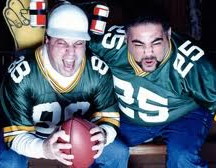May 9th, 2011 by RyanDuBosar in News, Research
No Comments »

One-third (33.5%) of female heart attack patients receive surgery or angioplasty compared to nearly half (45.6%) of men, and among heart attack patients receiving an intervention such as coronary bypass surgery or angioplasty, women had a 30% higher death rate compared to men, reports HealthGrades.
The findings are based on an analysis of more than 5 million Medicare patient records from 2007 to 2009 and focused on 16 of the most common procedures and diagnoses among women.
The most noticeable disparities were in cardiovascular care. Heart disease is the #1 killer of women in America, surpassing all forms of cancer combined, the company said in a press release. Read more »
*This blog post was originally published at ACP Internist*
April 1st, 2011 by John Mandrola, M.D. in Health Tips, True Stories
2 Comments »

My neighbor Ed was a thin man all his life. He maintained an ideal body weight by combining regular physical activity with a modest intake of calories. He was a “young” seventy year-old who looked the picture of heart health.
Ed regularly read the newspaper while walking on his treadmill, he hit a golf ball straighter and longer than his peers, and he wore the same size jeans now than he did in college 50 years ago. What’s more, he bragged about his low blood pressure, normal cholesterol level and perfect blood chemistries. He took no pills. I think he went to his primary care doctor each year just to show off his health.
The morning he woke with crushing chest pressure and shortness of air stunned him. “This couldn’t be a heart attack?” he thought. An hour later, minutes after his urgent heart catheterization showed severe blockages in all three of the main coronary arteries, a sternal saw provided a heart surgeon access to his dying heart.
Ed did well. The story had a happy ending. He still looks the picture of health, but now there’s a scar on his chest and a few pill bottles in his medicine cabinet.
How can a human who exudes heart health go to bed well and wake up with severe heart disease? What’s missing? What could Ed have done differently? Could his doctors have measured anything—over and above the traditional risk measures—that might have suggested his obviously higher cardiac risk? Read more »
*This blog post was originally published at Dr John M*
March 14th, 2011 by AnnMacDonald in Health Tips, True Stories
No Comments »

While I was browsing the produce section of my grocery store the other day, the sound of a panicked voice coming over the store’s loudspeaker made me jump. “Does anyone in the store know CPR? Anyone? CPR? We need you in baked goods!”
I froze. In theory, I know how to perform CPR — cardiopulmonary resuscitation. I took a two-hour course on it nearly 25 years ago. But I hadn’t given it much thought since then and I certainly hadn’t practiced what I learned.
My mind started whirling as I tried to remember the sequence of steps. They’d changed the rules a few years back — I knew that much — so I wouldn’t have to do mouth-to-mouth resuscitation. But where exactly on the chest was I supposed to push? Should I form a fist and push down with my knuckles, or use the ball of my hand?
Suddenly, sirens wailed outside the store. The rescue squad had arrived. Too late, as I learned afterward, for this man, who was a victim of a sudden cardiac arrest. This type of heart attack strikes so fast that there usually aren’t any warning signs. You might see someone grasp his or her chest, collapse, twitch and gasp a few times, and then lie deathly still.
At that point, every minute counts. Enough oxygen remains in the person’s bloodstream to nourish the brain for several minutes — but a bystander has to circulate oxygenated blood to the brain and other organs by pushing down on the chest hard and fast, mimicking the heartbeat.
I’m a health writer. I knew this intellectually. But until those agonizing moments in the grocery store, I never really understood on a gut level just how important every minute is. Read more »
*This blog post was originally published at Harvard Health Blog*
February 10th, 2011 by PJSkerrett in Health Tips, Research
No Comments »

 As a youngster, I loved being part of the baby boom — it meant there were dozens of kids on my block who were ready to play hide-and-seek or join mysterious clubs. Now that I’m of an AARP age, there’s one club I don’t want to join: The one whose members have bypass scars, pacemakers, or other trappings of cardiovascular disease. The American Heart Association’s (AHA) gloomy new forecast on cardiovascular disease tells me it won’t be easy to avoid.
As a youngster, I loved being part of the baby boom — it meant there were dozens of kids on my block who were ready to play hide-and-seek or join mysterious clubs. Now that I’m of an AARP age, there’s one club I don’t want to join: The one whose members have bypass scars, pacemakers, or other trappings of cardiovascular disease. The American Heart Association’s (AHA) gloomy new forecast on cardiovascular disease tells me it won’t be easy to avoid.
The AHA foresees sizeable increases in all forms of cardiovascular disease (see table) between now and 2030, the year all of the boomers are age 65 and older. Those increases will translate into an additional 27 million people with high blood pressure, eight million with coronary heart disease, four million with stroke, and three million with heart failure. That will push the number of adult Americans with some form of heart disease to 110 million.

(Percentages refer to the percentage of Americans aged 18 years and older.)
If the AHA’s projections are accurate, the cost of treating cardiovascular disease would balloon from $272 billion today to $818 billion in 2030. Add in the cost of lost productivity, and it jumps to more than $1 trillion. Yikes!
Although obesity and inactivity are part of the problem, much of the increase comes from the graying of the baby boom. We can’t stop boomers from aging, but we can fight cardiovascular disease, a condition the AHA calls “largely preventable.” Read more »
*This blog post was originally published at Harvard Health Blog*
February 6th, 2011 by RyanDuBosar in Better Health Network, Research
No Comments »

 Sports fans may literally live and die on their team’s victories, according to researchers who examined cardiac mortality rates after the home team won and lost the Super Bowl.
Sports fans may literally live and die on their team’s victories, according to researchers who examined cardiac mortality rates after the home team won and lost the Super Bowl.
Total and cardiac mortality rates in Los Angeles County increased after the football team’s 1980 Super Bowl loss but overall mortality fell after the 1984 the team’s Super Bowl win, researchers concluded from a review of death certificates reported in Clinical Cardiology.
First, authors gave a clinical review. Stress causes a cardiac cascade. The sympathetic nervous system increases and releases catecholamines. This triggers a rise in heart rate and blood pressure, and ventricular contractility increases oxygen demand, causing blood the sheer against and fracture atherosclerotic plaque, the authors explained. Stimulation of alpha receptors in the vasculature further constrict coronary vessels, increasing oxygen demand while limiting oxygen supply to the heart.
Next, they gave a sporting review. Los Angeles has played twice in the Super Bowl, the first time losing to the Pittsburgh Steelers (who play in this Sunday’s Super Bowl, incidentally) in 1980. The Los Angeles Rams, as they were known then, were a long-time hometown team and played the game in nearby Pasadena, Calif. “This game was high intensity,” wrote the authors, “with seven lead changes before Los Angeles lost a fourth-quarter lead and the game.”
Later, a new football franchise arrived in town, the Los Angeles Raiders. In 1984 the Los Angeles Raiders traveled to Tampa, Fla. to beat the Washington Redskins in a more mundane affair.
Now, the review of findings. Researchers combed death certificates based on age, race and sex to compare mortality rates for Super Bowl-related days with non-Super Bowl days and created regression models predicting daily death rates per 100,000. Read more »
*This blog post was originally published at ACP Internist*















